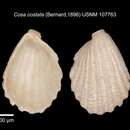fr
noms dans le fil d’Ariane


“Philobrya costata, Bernard, 1896. Plate 51, fig. 13.
Shell small, thick, ventricose, very inequilateral, subquadrangular, strongly radiately ribbed. Beaks close together, with a distinct flat and oblique prodissoconch, inclined towards the inner and posterior sides, with a sharp raised margin and slight radial striations. Anterior end nearly straight, descending obliquely and forming an angle of 60° to 70° with the dorsal margin. Posterior end short and straight or lightly excavated above, very lightly convex at the lower half; basal margin regularly curved. Lunular area large, cordiform, flat, with concentric riblets. Excutcheon lightly keeled. Sculpture consisting of 11 equidistant strong radial ribs, each with a distinct median groove, the interstices near the base almost of the same width as the costæ; to these riblets have to be added 3 to 4 thin simple concentric cords upon the lunular area; the interstices and riblets are ornamented with close wavy and sharp concentric striæ. Epidermis produced into double hair-like processes upon the riblets, and extending beyond the margins of the valves. Colour light brown. Interior light brown, with white radiate rays, corresponding to the interstices on the surface. Margins denticulated by the extension of the costæ, and finely crenulate. Hinge-plate narrow, with a long crenellated posterior ridge; below the anterior portion of the beak there is a short subquadrangular and cancellated area with 3 roundish small tubercles in front. Ligament oblique, below the posterior part of the umbo, the greater part of it internal, but distinctly visible from the outside. Adductor-scar distinct, small and round, posterior. Pallial line simple, not very distinct.
Diameter – Ant.-post., 2.5 mm.; dorso-ventral, 3.2 mm. : thickness, 2.2 mm. : prodissoconch, 0.35 mm. (type).
Type in the Mus. Hist. Nat., Paris.
Hab. – Stewart Island, in 35 fathoms, type (Filhol); Whangaroa Harbour (C. Trail); Lyttelton Harbour; Otago Peninsula (T. Iredale); Taumaki Island, in 10 fathoms (Captain Bollons); Foveaux Strait, in 15 fathoms (A. Hamilton); north-east of Wreck Reef, in 50 fathoms, and off south-east of Cape Saunders, in 100 fathoms (E.R. Waite); near the Snares and the Bounty Islands, in 50 fathoms (Captain Bollons).
In the littoral zone the shell may be found under stones and on seaweeds.
Remarks. – The species is variable in form, the anterior end sometimes descending almost vertically, and the posterior side being more or less produced.
The Pliocene P. trigonopsis, Hutton (Mytilicardia), is very nearly allied, but the riblets are finer and more distant, and they are lacking the median groove.”
(Suter, 1913)
Cosa costata is een tweekleppigensoort uit de familie van de Philobryidae.[1] De wetenschappelijke naam van de soort is voor het eerst geldig gepubliceerd in 1896 door Bernard.
Bronnen, noten en/of referenties